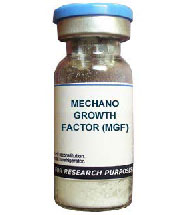Since this is primarily a steroid-related website I guess every now and then I should discuss steroids and their pharmacology. What I want to examine with this article, however, is not the actual steroid but what is attached to most injectable steroids – the ester. This is the attachment that helps the steroid survive for longer in the body, rather than being rapidly broken down into its amino acid constituents and used for fuel. The process by which these (Polyethylene Glycol [PEG]) polymers are attached to the steroid is called PEGylation. Along with increasing the half-life, PEGylation also increases the drug stability and solubility so it can be suspended in a water or oil based medium. But PEGylation is not without its problems. While you, the consumer, get a vial of unadulterated product (unless you buy some cheap, shady garbage), the production process is far from perfect. For example, residues on some proteins to be PEGylated can disrupt the procedure, leading to low bioactivity of those particular molecules. In addition, the PEGylation links formed can be at different sites throughout the molecules, leading to what the researchers describe as a “final product (that) is poorly defined.” Ultimately, the final yield can be as low as 20% from what was started with, resulting in the waste of a lot of potentially expensive materials. In addition, from the viewpoint of the end-user, there is the fact that PEG is generally considered to be a non-biodegradable polymer, although some reports suggest that certain dehydrogenases and cytochrome P450 oxidases can degrade it.
Because of these problems, biomedical engineers from Duke University set themselves the task of developing a new way to protect protein-based drugs with six set guidelines to adhere to;
1. It has to be a stoichiometric conjugate (typically 1:1)
2. They have complete control of the site of conjugation
3. There is a high yield (>50%)
4. They have good control of polymer dispersity
5. The molecule has a high retention of protein activity
6. There is a significant improvement in the pharmacokinetics and bioavailability of the conjugate compared to the unmodified protein
In English for the layman, this means they want a protected molecule that still works despite the protection, where they can control where the protection is added and end up with a good batch each time. The stoichiometric conjugate bit is just a fancy way of saying they’d prefer to have an attachment around the same size as the protein, rather than a huge protective attachment.
What they came up with was quite remarkable. Rather than attach chains of PEG to the molecule, they picked a specific site to grow the polymer out of the protein. This avoids any residues that can affect the biological value, and alone increases the potential yield of the end-product significantly. In addition, they chose not to use PEG, but instead used something called Poly(oligo(ethylene glycol) methyl ether methacrylate), or poly(OEGMA) for short. But since it is still not a very short acronym, I’ll refer to it from now as simply poly-O. One of the cool things about poly-O is that it is synthesized via a procedure known as atom transfer radical polymerization (ATRP), which gives the manufacturer great control in determining the polymer chain length. The chain links are also biodegradable in the body, so there is no concern for poly-O build up in tissues. In order to give you a better idea of the structure of poly-O, let me quote one of the researchers who describe it as a “PEG-like polymer conjugate with a notably different polymer architecture—a PEG-like comb polymer—as compared to the predominantly linear and lightly branched PEGs that are currently used in the biopharmaceutical industry”.
To demonstrate how good this new conjugate is, they experimented with myoglobin, a compound with a half-life of around three minutes. After two hours in the body, it is gone. Poly-O myoglobin, however, had a half-life forty times greater, and stayed in the body for eighteen hours. Naturally, this research is being conducted to assist cancer therapies and the like, but it does raise the eyebrows for the potential of what it can do for short-acting anabolics. MGF and IGF-1 for instance, and even testosterone base, would all become much more interesting, but more research is needed.
Source: Gao W, Liu W, Mackay JA, Zalutsky MR, Toone EJ, Chilkoti A. In situ growth of a stoichiometric PEG-like conjugate at a protein’s N-terminus with significantly improved pharmacokinetics. Proc Natl Acad Sci U S A. 2009 Aug 25.

